Namibia
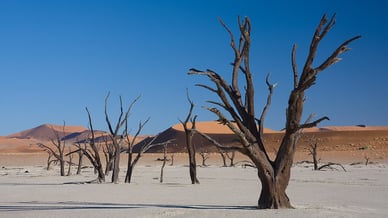
Deadvlei in the Namib Desert, Namibia
Namibia is a perfect place to start your discovery of true Africa. Here are a little comfort and much extreme, a little water and much heat. Africa is for those who appreciate a pristine charm of wild nature and are adept at real tourism, unmitigated by civilization.
The stark beauty of the Fish River Canyon, the eerie landscapes of Skeleton Coast that is the part of the oldest desert in the world, and the rock engravings of Damaraland make Namibia gorgeous and grand.

Historical background
Namibia has existed as an independent state since 1990. Before that, it used to be a territory with a dramatic history behind it.
At different times, it belonged to the tribes of indigenous inhabitants; it was also under British rule, and at the end of the 19th century, it became a German colony.
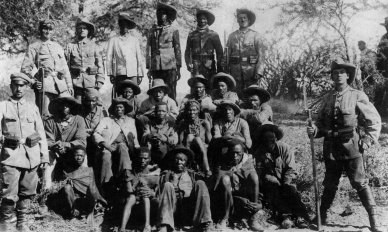
German soldiers posing with Nama prisoners, circa 1905.
Murderous wars went along with each shift of power. Thousands of people died during the years of confrontation.
Later, the region was under the control of the Union of South Africa, the predecessor of the South African Republic.
The latter one seceded from the Union but reserved its right to control the territory of Namibia and later intentionally turned it into a real ghetto for the indigenous communities.
The violent apartheid policy was brought to an end only in 1990 when Namibia received the status of a fully functioning sovereign nation after a 24-year struggle for independence.
Now the country’s population is estimated at 2.5 million people, and the current estimates of the White Namibians run around 5%.
The other part includes the representatives of 11 indigenous communities: the Owambo, the Nama, the Herero, the Damara, the Caprivi, the Himba, and others.
Namibian geography is unique, having two deserts at once: the Kalahari on the east and the Namib on the west.
The latter is the oldest desert in the world where the Atlantic coast with its gushing waters gets its start. Jungles prevail in the northern part of the country.
Namibia is one of the richest African countries, but this prosperity is very figurative. It is renowned for the biggest diamond deposits and uranium mining.
Every day, multi-million-dollar deals are concluded on the Namibian Stock Exchange based in Windhoek. Though there is much copper, gold, wolfram, and gas in the interior of Namibian earth, the people here live in extreme poverty.

View of the Navachab gold mine
One-third of the Black population lives on $1 a day. The other 53% of those who are luckier can afford to spend $2.
On the contrary, White citizens, who make only 5% of the general country’s population, spend not less than half of the national revenue.
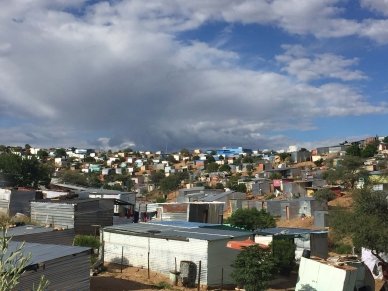
Slums in Namibia
Despite Namibia’s independence lasting for more than 30 years, its economy is still directly and closely connected to the former overlord, the South African Republic.
Even the national currency - the Namibian dollar - depends on the exchange rate of the South African rand circulating freely within Namibia's territory.
Windhoek: A ‘Windy Corner’ among the Rocks
Until 1890, the capital of Namibia had been just a piece of land owned by the Nama.
Scanty vegetation, sand, and rocks were the only assets of future Windhoek at that moment.
But then Curt von François, the Kaiser army officer, came here, rudely banished the indigenous people, and started construction of the fort that became the inception of a new city.
The Nama made several attempts to turn their territory back, but the colonizers defeated all the uprisings.
The settlers constructed the city in their own way: the entire ancient architecture has had the spirit of Kaiser’s Germany till today. In 1904, the Christuskirche, (also Christ Church) was built.
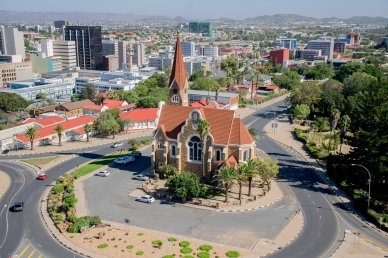
Christuskirche (Christ Church)
After that, the Ink Palace (Tintenpalast), the current seat of the Namibian Parliament, emerged.
Both masterpieces were built in neo-Romanesque style and designed by the German architect Gottlieb Redecker.
Apart from the ancient architecture, Germany reminds about itself through many legacies like newspapers, Goethe Institut courses that provide training and certificates, pubs, bars, and cafes that serve excellent beer, sausages with cabbage, Eisbein, and other dishes of German national cuisine.
Now Windhoek is the largest city in Namibia with a population of 300,000 people, the majority of whom are indigenous Africans - the representatives of several local ethnicities.
There are not many White people, and almost all of them are the descendants of German colonizers and Afrikaners who have relocated here from the South African Republic.
Here you may hear English, German, Afrikaans, and the dialects of all native tribes. The city as well as the whole country is multinational and multilingual, and this is its exquisite beauty.

Windhoek, Namibia
The capital is the centre of politics and business where the Namibian government and Stock Exchange function along with establishments and offices of different companies.
The Windhoek tourists are offered an interesting tour to visit the National Museum of Namibia, National Art Gallery of Namibia, Owela Museum, and the Geological Survey Museum.
Air Namibia's head office is also located here.
Climate
In general, the climate in Windhoek is temperate in comparison with the other capitals and countries of Africa.
The annual average temperature here is 19.5 °C. The city is also advantageously located on the border of the tropics.
The mountains on the south protect it from the winds.
Summers are dry and hot. The daily temperature may reach 30-35°C. The heat of the day is over in the evening when coolness comes and remains till the morning.
Everyone who is going on a tour to Africa has to keep in mind that summer in Namibia begins in October and ends in March.
In Namibia, it may rain in winters, and the average annual precipitation of 330 millimetres is quite a lot for the African continent.
However, this affects city life quite favourably. Much greenery there gets enough water in a natural way.
Though, droughts are a common thing too, so all the rainwater is thoroughly collected and kept in reservoirs.
As in entire South Africa, winter in Windhoek begins in June and ends in August.
At this time, the weather is very comfortable for tourists who are not in favour of extreme heat.
The temperatures during the day range from 20 to 24°C, but nights are quite chilly - 0 - +5°C.
Hotels in Namibia: where to stay
Although tourism in this country has not reached the top level yet, it is under constant development. Guests from all over the world choose to stay in hotels, bungalows, campings, and lodges.
By the way, German and British residents are the most frequent visitors to Namibia.
This may stem from the ancient connectedness with colonizing ancestors.
Tourists from these countries impose high standards on service quality, so local hoteliers have no choice but to strive to meet these requirements.
The top five most popular hotels in Namibia are:
- Rieks van der Walt Self-Catering (Windhoek) is a four-star apartment with a patio. Guests have Internet and Wi-Fi access, and free private parking. The accommodation is not far from shopping malls and Warehouse Theater. Pets are allowed as well. Since it is a hotel of a self-catering type, guests have an equipped kitchen available.
- Luderitz Nest Hotel (Luderitz) is a cosy hotel overlooking the Atlantic Ocean. There is a warm swimming pool, access to Wi-Fi, parking, and car hire available. There is also a special present for guests - a free breakfast.
- Gulton House (Windhoek) is a BB type hotel located in the centre of the Namibian capital. There are non-smoking rooms, a restaurant, Wi-Fi access, private parking, and car hire service. Gulton House is perfectly suitable for those going to hunt around Daan Viljoen situated half an hour from the city.
- Bagatelle Kalahari Game Ranch is a tourist place with a luxurious bungalow on the edge of the Kalahari desert. There is a private mini zoo as well. The meals served here include the dishes of local cuisine and exotic meats like antelope, crocodile, etc.
- Desert Horse Inn (Klein Aus Vista, Lüderitz suburbs) is the exotic Eagle’s Nest campsite that consists of eight granite houses, built into the slope of the cliff. Each room has a bath, a mini-bar with cold drinks, and their main feature - furniture made of rock.
Customers’ feedback indicates that Namibian hotels create an overwhelming impression.
They are clean and quiet, offer diverse and tasty meals, and affordable prices.
Places of Interest: where to go, what to see and what to do in Namibia
No one will remain indifferent after a visit to Namibia.
There will be an abundance of impressions even if you concentrate your trip merely on Windhoek. The capital city attracts visitors to all national museums located there.

Those who aspire to adventures and exotics should pay attention to the most spectacular tours - the top 10 Namibia’s sightseeing attractions:
- Fish River Canyon is an ancient canyon of 6-7 hours’ offroader ride from Windhoek. Only the Grand Canyon in the USA is larger and deeper. Fish River is an unimaginable and unforgettable spectacle with the equipped and secure viewing decks and services of experienced guides.
- Quiver Tree Forest is a place where giant quiver trees grow. The most striking views can be seen during sunsets, so photography enthusiasts should not miss an opportunity to take photos of this unique beauty.
- Lüderitz is a port town named after one of the first German colonizers in Namibia. It is a must to visit Kolmanskop ten kilometres from the Lüderitz inland, a ghost town that became abandoned in the 1930s.
- Sossuflei is a part of the Namib-Naukluft National Park, a beloved place for tourists coming from all over the world. The open ground, Dead Trees Valley, and glorious sunset views make Sossuflei gloomily beautiful.
- Swakopmund is worth visiting on the way to the Etosha National Park. This small beach resort on the Atlantic coast lures tourists to look at the seal sanctuary, take a boat trip, or enjoy an ATV ride through immense dunes. It is also possible to see the city from above flying in a private aircraft or flip a coin into the ocean for luck when leaving this hospitable place in the hope to come back.
- Cape Cross is the best place for those who adore observing the big shiny fur animals that lazily bask on the coast. Located 1.5 km from Swakopmund, this seal paradise is the biggest brown fur seal colony in the world. Besides, tourists may also bring the souvenirs - salt crystals - sold at the entrance to Cape Cross.
- Etosha National Park is the jewel of the Namibian crown. Hundreds of tourists come here every day. Cliffs, small canyons, plains, numerous reservoirs are the places to see African animals in their natural habitat.
- Damaraland is a terrain located not far from the Etosha National Park. Eternal sands, ancient cliffs, plains, and dry riverbeds can be seen here, at one of the most beautiful places of Namibia. On the way to the region’s capital, Khorixas, it is recommended to visit Twylfelfontein to see spectacular cave paintings aged at least 8,000 years.
- The Himba village is a great opportunity to get a closer look at the life of this African tribe. The village tour, communication with residents, and loads of photos to remember the visit is worth spending time. This settlement is also located not far from the Etosha National Park.
- Skeleton Coast National Park is an indispensable part of the right tour to Namibia. Though the entry to the National Park is restricted, tourists still manage to see the remains of the wrecked ship, abandoned buildings, waterfall, and singing dunes that can be heard roaring within tens of kilometres.
Namibia is one of the few African countries where safari - wild animal hunting - is allowed.
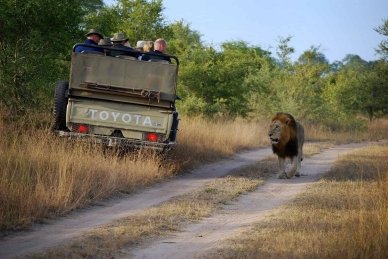
Safari in Namibia
You can also just buy a skin - this is an absolutely legal purchase here. Hunting can be organized by local guides who make money on tourism.
It is worth noting that Namibian roads are a difficult thing.
Tar roads make only 5,000 km out of the total 65,000 km.
The rest are covered with gravel, so an all-wheel-drive vehicle is absolutely necessary for everyone willing to get around the country at least somehow.
Food
Namibians and travellers eat what they like because there is no authentic national cuisine.
Restaurants and cafes offer different dishes. Tourists may order pizza, burgers, German sausages with cabbage, or try something local and exotic.
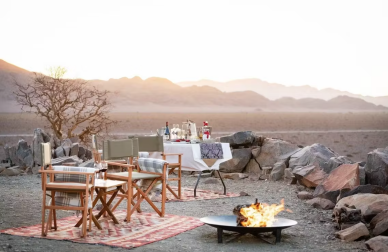
On private tours of Namibia, you can enjoy lunch with stunning views
A brave appraiser of exotic food will be offered an antelope steak, crocodile meat stew, birds’ eggs, lion fillet, or any dressing made of ants or termites.
Thousands of seafood lovers come to Namibia every year to purposefully indulge in eating the Namibian oysters, which are the biggest and most delicious in the world.
An interesting fact is that local beer is brewed following the old German recipes, and the result is not worse than somewhere in Berlin or Düsseldorf.
Moreover, Windhoek holds its local Oktoberfest, the celebration for beer lovers, on the same grand scale and atmosphere as the Germans do.

Windhoek's local Oktoberfest festival
Namibia is a good option for the first trip to Africa.
Non-extreme heat, good service, availability of tour guides, and affordable prices will surely make this experience unforgettable.
Adept travellers to Africa appreciate this country for the opportunity to delight in untrodden paths and plunge into this thrilling and mysterious world.
FAQ
When did Namibia gain independence?
Namibia gained independence on March 21, 1990.
Who ruled Namibia?
Before independence, Namibia was ruled by Germany (as German South West Africa) and then by the Union of South Africa.
What is the currency in Namibia?
The currency of Namibia is the Namibian dollar (NAD).
What is the capital city of Namibia?
The capital city of Namibia is Windhoek.
What is the population of Namibia?
The population of Namibia is about 2.5 million.
What language is spoken in Namibia?
The official language of Namibia is English, although many local languages are used alongside it.
What is the main religion in Namibia?
The main religion in Namibia is Christianity.
What is the territory of Namibia?
The territory of Namibia is about 824,292 square kilometers.
What is Namibia famous for?
Namibia is known for its deserts, including the Namib and Kalahari, as well as its rich wildlife and national parks such as Etosha.
What is the climate in Namibia?
Namibia's climate ranges from desert in the west to semi-desert and subtropical in other parts of the country.
What is eaten in Namibia?
Namibian cuisine includes meat (especially beef, lamb and game), fish, and maize and millet as staple crops. Traditional dishes made from local produce are also popular.
Is Namibia safe for tourists?
Namibia is considered one of the safer countries for tourism in Africa. As with any other country, it is important to observe general precautions: avoid unlit or remote streets after dark, do not leave personal belongings unattended, and be careful with money and valuables. In general, tourists who adhere to standard safety precautions and use common sense usually do not experience serious problems in Namibia.







